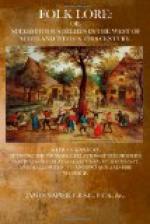consideration to fix upon a lucky day and hour for
the knot to be tied. With this object astrologers,
sooth-sayers, and others of that class were consulted,
who, by certain divinations ascertained the most auspicious
time for the union to take place in. When the
day arrived every occurrence was watched for omens.
A crow or turtle dove appearing near was a good omen:
for these birds symbolized conjugal fidelity.
The ceremony was begun by sacrificing a sheep to Juno,
the fleece being spread upon two chairs on which the
bride and bridegroom sat: then a prayer was said
over them. The young wife, carrying a distaff
and spindle filled with wool, was conducted to her
house, a cake, baked by the vestal virgins, being
carried before her. The threshold of the house
was disenchanted by charms, and by annointing it with
certain unctuous perfumes; but as it was considered
unlucky for the new-made wife to tread upon the threshold
on first entering her house, she was lifted over it
and seated upon a piece of wool, a symbol of domestic
industry. The keys of the house were then put
into her hand, and the cake was divided among the
guests. The first work of the young wife was
to spin new garments for her husband. It will
be seen that many of these practices were mixed up
with superstitious notions, many of which were prevalent
in this country sixty years ago, and some of which
still remain in country districts. Sixty years
ago when a young woman became a bride, she in a great
measure secluded herself from society, and mixed but
little even with her companions, and on no account
would she show herself at church until after her marriage,
as that was considered very unlucky. The evening
before the marriage her presents and outfit were conveyed
to her future home under the superintendence of the
best maid (bridesmaid), who carried with her a certain
domestic utensil filled with salt, which was the first
article of the bride’s furnishing taken into
the house. A portion of the salt was sprinkled
over the floor as a protection against an evil eye.
The house being set in order, the best maid returned
to the bride’s house where a company of the
bride’s companions were met, and then occurred
the ceremony of washing the bride’s feet.
This was generally the occasion of much mirth.
And this was in all probability a survival of an old
Scandinavian custom under which the Norse bride was
conducted by her maiden friends to undergo a bath,
called the bride’s bath, a sort of religious
purification. On the marriage day, every trifling
circumstance which would have passed without notice
at other times was noted and scanned for omens of
good or evil. If the morning was clear and shining,
this betokened a happy cheerful life; if dull and
raining, the contrary result might be anticipated.
I have known the following incidents cause grave concern
about the future prospects of the young couple:—A
clot of soot coming down the chimney and spoiling
the breakfast; the bride accidentally breaking a dish;




